JOURNAL – week 1 – Starting a Journal –
#grind #chrisbrooks #guitartechniques #jenslarsen #jazzguitar #musictheory
Or at least trying to…
So every YouTuber it seems recommends keeping a journal, because some progress will be subtle, and you won’t see it in the moment, or a week later. But then you can look back and see it a month, or a year, later.
I agree with that sentiment. Rocksmith does a wonderful job of keeping track of your “scores” and your ability to progress within a scale, song, or lesson. It was great seeing every little achievement, or challenge completed.
It’s why I am here now. It’s why I “play guitar” for on average 9+ hours a day, for 365 days apparently.
BUT I developed a bad habit of not keeping the journal myself.
I also only really worked on songs, instead of technique, tone, or skill.
Now that chemo is done; that will change.
I have been to four private lessons thus far, but we were just focused really on breaking bad habits while learning the notes on the fretboard via the pentatonic major, minor, and blues scales and the major and minor scales.
I am so grateful for knowing the C-major scale from so many years of band warmup. It really helped me learn the scale onto the guitar starting at both the 3rd fret on A, and 8th fret on low E.
I’ll have an article on that, once I start feeling remotely competent in it, and I’ve heard that’s a lifelong pursuit. It really is thrilling to know the depth of this rabbit hole I’ve found will keep me busy discovering new things every day. The basics though, as a teaser, is to work from one note, to the next. Then start over, and go to three, then 4, etc until you finish the scale.
So C – D
C-D-E
C-D-E-F
C-D-E-F-G
C-D-E-F-G-A
C-D-E-F-G-A-B
C-D-E-F-G-A-B-C
And don’t mess up. You mess up, you start over. This was a drill we did as a band, and if anyone messed up
We started over
Looking back, I get it now, and at the time it was maddening and fun. I remember when someone genuinely messed up, and we were so close to the end. She started doing her 5 pushups, and another member of her group (horns) started doing them with her, so I dropped my sousaphone (also pushups at the time were a great respite from the weight of that freaking thing! Lmao)
And everyone joined
Priceless
Then after getting to 8, you start adding speed, while staying in tone and clean. I can’t stress that part enough, it’s why it took me three months to remotely think about completing both Jens Larsen’s “Modern Jazz Guitar Secrets” and Chris Brooks’ “Thirteen Week Guitar Technique Bootcamp” first chapters.
Three months to just try out their first chapters and skim the books on the guitar
3 months.
So just keep at it.
I don’t want to talk about how frustrating it was, to play both books in a single afternoon on piano. I knew I was getting some tones wrong, but I was also getting lost on the fretboard. So I went back to the piano, saw my mistakes, then decided to do the whole books.
Probably not the best idea for an imposter syndrome kind of feeling of inadequacy but I enjoy those feelings, and live for that stress. If I’ve gotten there on piano, I can get there on guitar.
In an afternoon, both books, front to back –
BUT there’s decades of experience there, including in “hi-stress” environments, and to be fair, it was all the right, melody, hand. So the notes have been there since I was 12.
90 days though on guitar to get through chapters 1, with any sense of competence
Take breaks for sure.
But keep at it.
So to start the journal I’m just copying Chris Brooks’ wonderful book I’m following for intermediate guitar techniques, and I plan on going through this book twice.
And realistically I’ll be real, I’m not sure if the first time I’ll be able to accomplish each chapter in a week. I’m still learning tabs and the neck. I feel I’m more a “beginner trying to bull rush my way to intermediate-advanced, bashing my head through every obstacle that gets in my way”
I’m also now noticing there is a STARK difference between messing about on Rocksmith vs learning on Rocksmith vs actual dedicated practice with a timer, metronome, and WORK
Legit WORK
Tirade inducing WORK
“Tsundre” I think is the term for what Bakugo is, in “My Hero Academia” and Chika in “Kono oto Tomare” – a beautiful slice of life anime about a the traditional Japanese koto instrument, and their high school club – even if you’ve never watched anime, being here, with guitars interesting you, check it out. It’d be a great intro for a musically inclined person to see what Japanese Animation can be all about.
The tropes are the same as the mecha gundams and fanservice shows you’ve been warned about, because it’s Japan. As a culture it seems they live for stress, earning it, and going for the gold, whatever that gold is.
I’m retired now, forcibly, so I have all the time in the world
TO WORK
So on that
GOALS – I’m going to be setting a GOAL at the beginning of the week, based on what I know from years of Marching Band and Honor Guard Drill, and I may bite off way more than I can chew
For example within Chris Brooks’ book, he has drills that you work with a metronome once you learn exactly where they are and what he’s trying to teach you
60 bpm is fairly steady and easy for me to figure out, as a “slow, deliberate, and follow along pace” – years of 110-120 bpm marching. It’s also easy for me to slow it down to 45 when needed. I do think 30 bpm, and the deliberate slow, even notes, is actually harder than 90 bpm. So anywhere between 45-60 bpm is where I will start a drill.
According to Chris Brooks’ book, a new player like me, could try and push 15 bpm each run, so then it’d be
60 bpm
75 bpm
90 bpm
For the three tempos
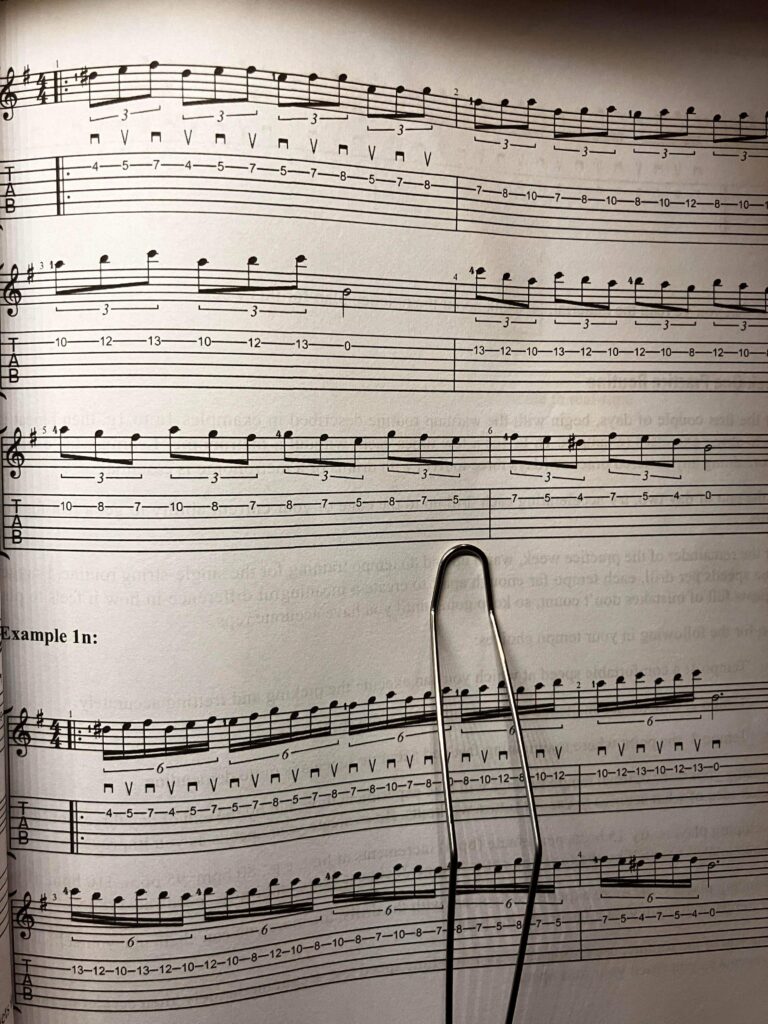
Which is daunting to be real. 90 bpm is 50% faster than 60 bpm. And more importantly at 60 bpm these triplets are played 1/3 a second each in this little example of his book below
*copied from his book, page 19*
Chris Brooks recommends this for Chapter 1
Chapter 1
| Drill | Tempo 1 | Tempo 2 | Tempo 3 |
| Example 1H | 1 x 6 Strings | 1 x 6 Strings | 1 x 6 Strings |
| Example 1i | 1 x 6 Strings | 1 x 6 Strings | 1 x 6 Strings |
| Example 1J | 1 x any 3 strings | 1 x any 3 strings | 1 x any 3 strings |
| Example 1K | 1 x any 3 strings | 1 x any 3 strings | 1 x any 3 strings |
| Example 1L | 1 x any 3 strings | 1 x any 3 strings | 1 x any 3 strings |
| Example 1M | 1 x any 3 strings | 1 x any 3 strings | 1 x any 3 strings |
| Example 1N | 1 x any 3 strings | 1 x any 3 strings | 1 x any 3 strings |
| Example 1o | Free Time | Accelerated | Max Speed |
Most singer-songwriter upbeat jams are around 110 bpm to 120 bpm
Most hair-band shredders are 110-130 bpm
“Way Down We Go” by Kaleo – is according to Google-fu, 84 bpm, which I clocked with the tapper app on my watch at 82, and on the Spark app, at 84.
“Slow Dancing in a Burning Room” by John Mayer, is at 67 bpm according to online, I’ve clocked it myself with a tapper at 74 bpm for the Los Angeles Nokia Theatre version
“Parachute” by Chris Stapleton is at 113 bpm according to google-fu, I’ve clocked it myself at 118 bpm for his SNL performance – which makes sense, sometimes the live televised shows – SNL, Letterman, etc end up having the artist speed up their song to make it fit the time slot
Anything under 90 bpm is considered slow, and cumbersome for marching, and we tend to split the beat. Usually a 90-ish bpm song is played as the “middle piece” in a half-time marching set. Think “Long Winding Road” by the Beatles, and you’ve got it.
Anything above about 130 bpm, we tend to slow down and split the other direction. About 110 bpm is pretty standard marching pace, at least for me lugging a big sousaphone around, and “double-time” for jogging is about 200+ to about 240 sometimes.
Usually in marching, a 110-120 bpm song is the first piece, followed by a 75-100 bpm in the second, then a 120-240/split big finisher – “He’s a Pirate”is 150 bpm, and of course with the drums and everything, was an absolute epic halftime show theme.
There’s a reason why certain songs or even themes and sets become “viral” for marching bands. “Pirates of the Caribbean” is arguably one of the best examples of that in the last 30 years.
If you’re new to metronomes, timing, and time signatures – *** I’ll have another article going into deeper detail soon –
Again, I HIGHLY recommend Chris Brooks’ book. It has made my performance level, and more importantly since I’m focusing on it at the same time, my TONE, SKYROCKET in the past few months of just trying the first chapter while learning tabs.
There will be a review in time, but “Val” – my beautiful Schecter C-1 Classic
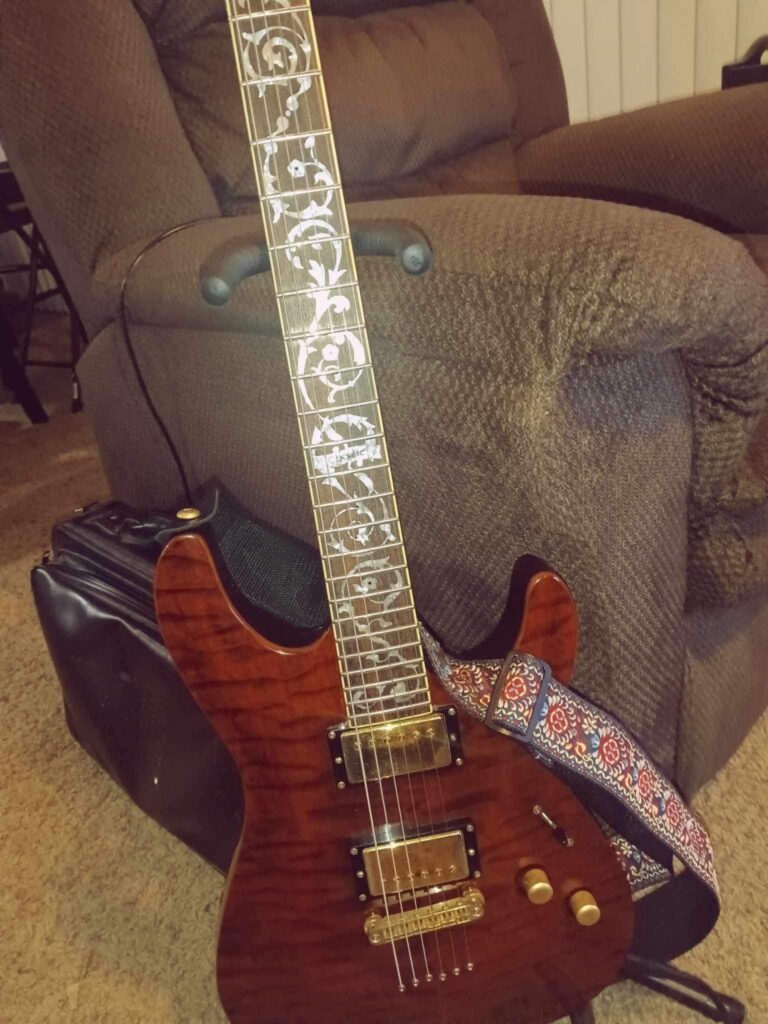
Probably learning tabs, notes on the fretboard, and having this complicated fretboard on a new guitar to learn, with a brass tune-o-matic bridge with jumbo stainless steel frets showing me every little detail of touch I’ve messed up –
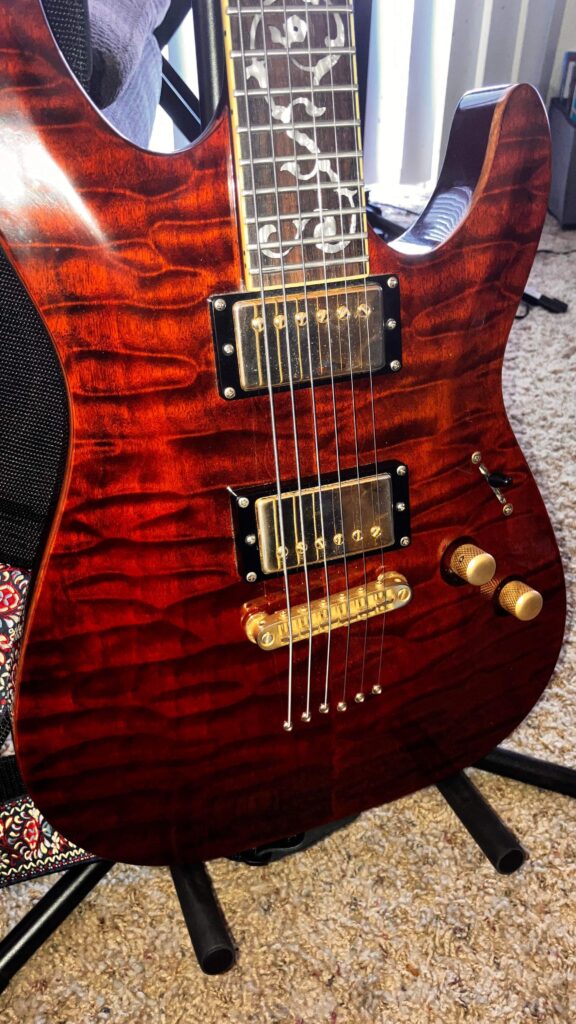
Was probably the most masochist thing I have done in the past 5 years – but boy was it worth it
This guitar came into my life practically at the same time as Jens Larsen’s “Modern Jazz Guitar Concepts” and Chris Brooks’ “Thirteen Week Guitar Technique Bootcamp” arrived at my door. I was in Guitar Center grabbing recording gear, and there was this beautiful instrument on the wall
I love this guitar. First unplugged tones I got from it, I KNEW she would be my “precious”and now, even after JIVAjr, and a REAL American Fender Stratocaster with Texas Tea pickups AND a pure maple neck, arguably what would be “my signature Strat” – don’t compare to “Val” to me for my jazz fusion tone. I may be an HH (humbucker – humbucker) kinda guy. But that’ll require more 4science research with JIVAjr and other guitars. ***Be sure to check out future #g+1 articles on all the guitars and also my continual pursuit of #tone
Val though, makes me EARN it. This is arguably the hardest guitar for me to play, but also the most rewarding. That tune-o-matic brass bridge, with those Ernie Ball Super Slinky 10’s strings, bright stainless steel jumbo frets and having a low jazzy action – it’s a chef’s kiss when I’m good, but they absolutely will tell me when I’m not on my game and will squeak worse than a 12 year old learning clarinet
*** more on this little 90 day tirade of pain and suffering and cussing that’d make all my sailor friends even blush to greatness, elation, and joy when I write my article on “Val” – my Schecter C-1 “Classic” in my #g+1 article series
Again, we’re all at our own pace, and my experience, and my time is very different than yours. I’m also a bit of a perfectionist, so I probably got frustrated with “Val” a lot more than I should have, and “Val” was NOT the easiest instrument to start these exercises with – but that’s also where I EARNED my tone I’ve developed so far.
And the best news, we are NOT alone:
If Joe Bonamassa can admit to his “on days” vs “off days” and how he gets his tones, we, certainly can. I love how transparent he is in today’s day and age. Same with John Mayer as well.
Two arguably “GOAT-status” dudes on guitar, are also humble and share everything they can
Chris Brooks doesn’t seem to be any different, except man does he love to show his shred capabilities
Chapter 1’s techniques learned are very similar to this video
Obviously I’m nowhere near his speed, and that does NOT matter. What matters for me, or for anyone reading this, is our own progress. It’s why I’m obsessed with guitar so much now. It’s only a “race” against myself.
He definitely shows me just how far I have to go, to earn “Legit Shredder STATUS!!” and can easily give me a heavy dose of “git good scrub” but I also like that. If we don’t have “unattainable” goals, then how do we strive to reach for them, and surprise ourselves when we MEET them?
I refuse mediocrity
If he seems like your cup of tea too, definitely LIKE and SUBSCRIBE to him, and BUY this BOOKS.
I 100% endorse this dude for techniques now. His books are how I found Jens Larsen, and back to Jazz in the first place. These “Fundamental Changes” series are absolutely EPIC. On amazon, you can see the whole list of jazz books for example, or Chris Brooks’ series, and others too.
I’m so excited. I kinda want to nerd out and work with one book, one chapter a week, eventually when I can sight-read with a guitar like I can trumpet, clarinet, and piano.
Seriously, my TONE is 100% due to trying to get the tone I’m striving for (mhmmm John Mayer + Stevie Ray Vaughn + David Gilmour + Eric Clapton + but also with the creamy humbucker goodness of Santana and Joe Bonamassa – so NO PRESSURE THERE!!!) , while trying to accomplish his warmup and chapter one, trying to be as clean as I can.
I’m also going to share my “BIG WINS” each day, or week, or whenever they show up
The BIG WIN this past week, was showing this to my instructor
and him showing me it’s built, rather beautifully but still, built on an “extended pentatonic scale shape with obvious other improvisation within it when she runs from one end of the neck to the other

And he figured that out, from my small iPhone, 10 feet away, first play through.
Now I just need to cross reference it to the actual scale root name – which shouldn’t be too hard, since I have “Way Down We Go” on Rocksmith
Looking at it paused above, it may even be G or A
BIG WIN #2 – being able to see these, by the way, is why I love private lessons, or working in a band/ensemble type format. You see the wins easily when your mentors, bandmates, group or rivals give you “that look”

It was epic and awesome showing him how I read this shape well enough. I really do feel like I’m starting to get my sight-reading chops for guitar. This is a HUGE WIN for Jazz or any time playing a song you may have only heard once, or just looked at the “cheat book” on for chord progressions.
Chord progressions by the way, I am kinda avoiding at this point besides working with the songs I know, and when learning a new song that has chords.
Slow and steady and avoiding them basically entirely.
I know, but right now I’m more focused on the melody first, then I’ll go to the arrangements and chord progressions, and learn those shapes as I learn a song.
There’s a method to my madness, I swear.
My plan this week for technique is Chris’ book, along with Jens Larsen’s Chapter 1 of his jazz book – basically just still working on all those arpeggios and trying them from different points on the neck.
Also for the “song” I’m trying to learn for JIVAjr is well, no pressure on ME
“Kintsugi” by Nita Strauss
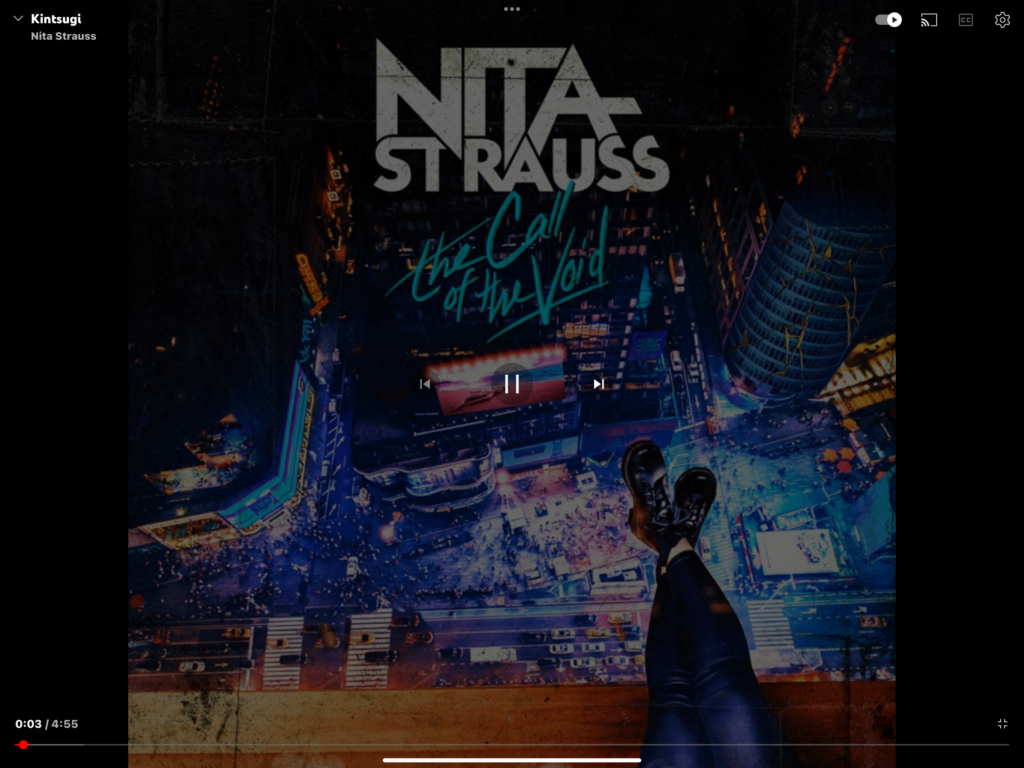
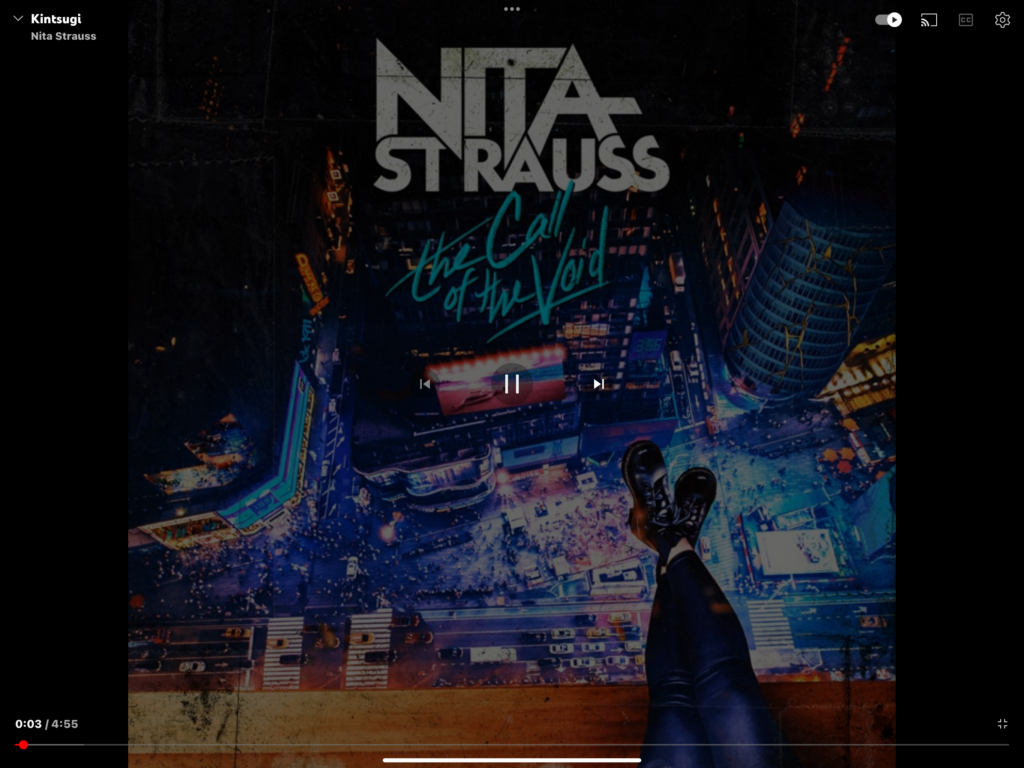
Kintsugi is a Japanese art tradition of taking something broken, putting it back together with basically a gold glue, or just straight up 24K gold sometimes, and making it new, and it’s also prettier.
https://thegreenmadhouse.com/diy/how-to-repair-your-broken-ceramics-with-kintsugi
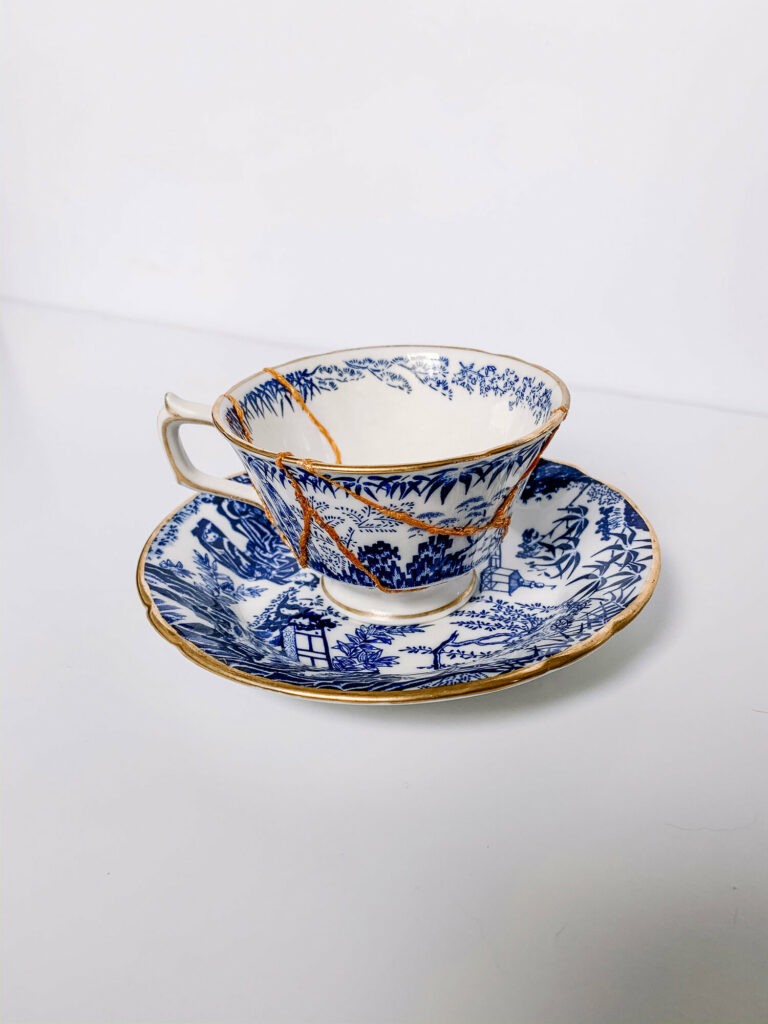
It takes the broken mess, accentuates the scars, and makes the entire object more beautiful in the process
There is no better symbolism for me, for a passion project, to take into auditions for University level jazz guitar, than learning this song.
Through the wreck that was 2022 and the rebuild that was 2023 – 2024 is going to be BAMF
Chapter 1
| Drill | Tempo 1 | Tempo 2 | Tempo 3 |
| Example 1H | 1 x 6 Strings | 1 x 6 Strings | 1 x 6 Strings |
| Example 1i | 1 x 6 Strings | 1 x 6 Strings | 1 x 6 Strings |
| Example 1J | 1 x any 3 strings | 1 x any 3 strings | 1 x any 3 strings |
| Example 1K | 1 x any 3 strings | 1 x any 3 strings | 1 x any 3 strings |
| Example 1L | 1 x any 3 strings | 1 x any 3 strings | 1 x any 3 strings |
| Example 1M | 1 x any 3 strings | 1 x any 3 strings | 1 x any 3 strings |
| Example 1N | 1 x any 3 strings | 1 x any 3 strings | 1 x any 3 strings |
| Example 1o | Free Time | Accelerated | Max Speed |
First Monday – learning the different scales, one part I kinda felt comfortable posting
I found this awesome article on the extended pentatonic scale that I’m now using for reference when I get lost on the fretboard
Usually around the D or G strings, I end up wondering where I am at times, especially on Val. So I’ve been working primarily with JIVAjr and now my American Fender Strat
Extended Pentatonic Scale: Break Out of the Pentatonic Box
https://appliedguitartheory.com/lessons/pentatonic-scale-extensions
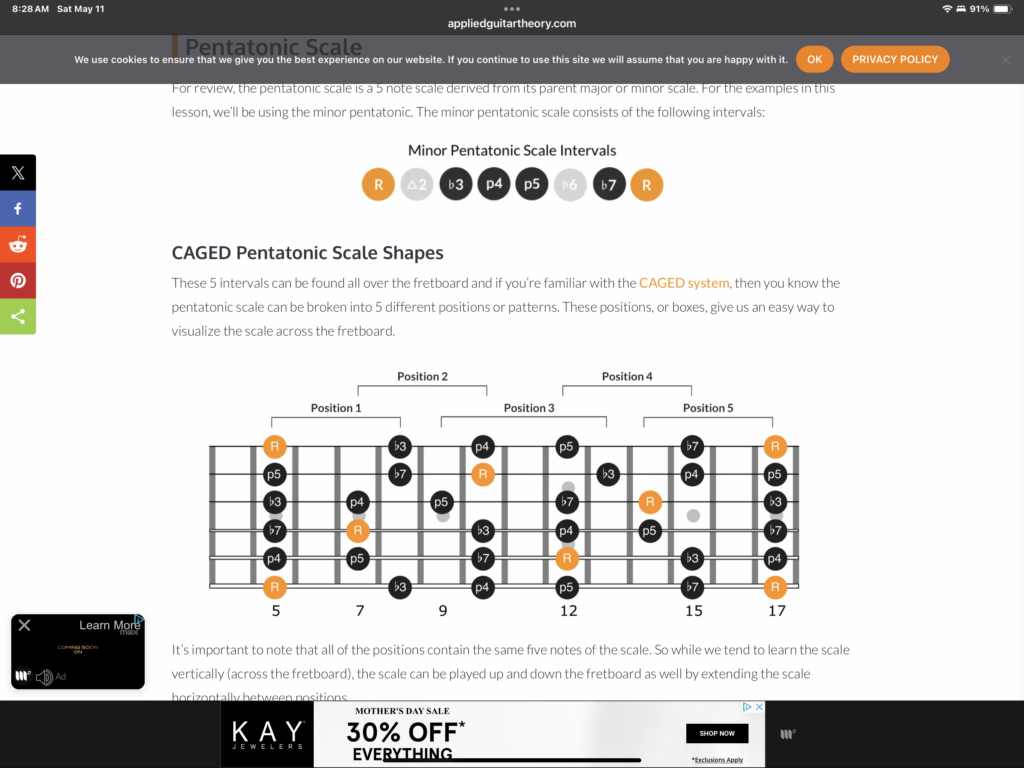
A lot of “Dots” to cover lmao
Let me start with I am NOT a fan of the “Caged” method. I believe that the way it is often used, especially in YouTube ads – is to create a problem and make things look absolutely daunting and impossible that it then overwhelms the student with, to then give the solution to that same problem. Thereby requiring the student to “NEED” their help.
Instead of just doing it the old fashion way of grinding scales, arpeggios, and learning the fretboard.
I say out loud, every note. If I change the scale, I also call out the sharps and flats – which then helps me remember which sharps and flats are in each scale – see? Smart.
However, the fretboard is the fretboard, and tuned in E-standard. They are all the same. So if CAGED works for you, go for it. Just don’t get caged up in the process.
This is the one and only time I’m going to reference it, and even then barely. I don’t like the marketing methods used with it, nor the sites or YouTube videos that seem to rely on it.
Music theory is music theory. To understand any instrument, you need to have a foundational knowledge within music theory.
But that’s another article, for another day. It’ll be another #grind article, and more my opinion than anything.
*** WHAT is a MUSICIAN article link here when posted***
But, thanks to working on a SCALE, and the EXTENDED Pentatonic SCALE I found this guy down undah
https://youtube.com/@joemacedomusic?si=pnFRNYp-IHy-9vPp
Not going to lie, I’m calling out my IT guy, and bff that he has a doppelgänger down under
So I’m adding this for week 2
No offense to Chris, I love his books and techniques, but this guy’s approach and talking about “don’t worry about your speed, just worry about progress”
It fits me, and I feel my private instructor, a bit better – I’m going to really work on Chapter 1 a lot more going forward until I can reach the speeds shown in the video above.

Trackbacks/Pingbacks